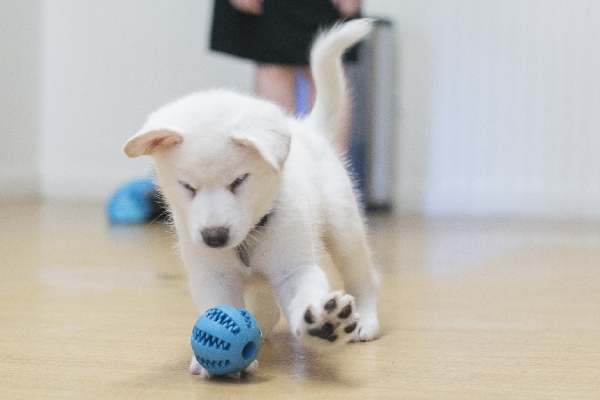Security, comfort and a lot of love will be some of your dog’s most basic needs.
But he will have a few tangible needs as well.
We recommend high-quality, high protein, balanced dog food twice a day for adult dogs. Young puppies should start out eating three to four times a day and move to two meals around four months.
Your dog should always have access to fresh, clean water. It should be changed at least two times a day.
A dog's bed is a source of comfort. Sleeping habits will depend on you! Many dogs will sleep with their owners; however, training professionals will not recommend this for dogs who require stricter boundaries.
If your pet does not sleep with you, create a cozy sleeping place, preferably with the pack (you or other humans/dogs in the house). We recommend having beds in rooms where they spend a lot of time.
Dogs need lots of exercise and socialization. Understanding your dog’s exercise needs, which can depend on breed, age and size, will help you develop an exercise routine that matches his personality.
Try taking your new dog or a walk, to visit with neighborhood dogs, to the dog park and in the car. Training and agility classes are another great way to exercise and strengthen the bond between you and your pet.
Dogs need to build up to longer and more intense exercise regimes. Puppies should stick to walking around the block and backyard playtime. A junior dog can evolve into your running buddy. As dogs approach their senior years, exercise is also important to maintain muscle mass on aging joints. Exercise needs may change with health condition, so make sure to assess your dog’s ability to keep up as he ages.
Providing an enriched environment full of positive stimuli will lay the groundwork for a happy, healthy dog. Dogs are pack animals, and they thrive on being part of your family’s pack.
At least three times a day, play with your dog or take him for a walk for 15 to 30 minutes. This will help him feel like a true member of your family. During playtime, change out his toys to keep him interested and challenged. And of course, reward good behavior with lots of pets, positive praise and a few treats!
When you’re ready to bring your pup home, remember to pick up these supplies:
- Dishware: We recommend stainless steel, glass or ceramic food and water bowls. Avoid plastic containers. Plastic can shed toxins in food and water and the porous material encourages bacterial build up.
- Collar: Dogs should have a martingale-style or buckle collar that can carry an ID tag and a rabies tag. Make sure your dog’s collar fits properly. You should be able to put two fingers between the collar and the dog’s neck. Consult your veterinarian or a trainer to see if a different type of collar is right for your dog.
- Leash: Leashes should be 4 to 6 feet long to ensure good control of your dog. Retractable leashes are not recommended, as they do not give you as much control. In public, your dog should be on a leash at all times. Even the best-trained dogs can become scared or chase perceived prey and run into traffic. If you have a secure, fenced-in yard, it’s OK to have your dog off leash.
- Toys: Toys are a great way to provide your dog with mental and physical stimulation. Experiment with a few different types of toys to discover your dog’s preference. We recommend Kong brand toys and other well-made toys that involve a mental challenge. A Kong Classic is a hollow toy that can be filled with treats. Your dog will work at the Kong to get the treats out. Check out these Kong Stuffer recipes Be mindful of small parts. Many toys come with a squeaker inside, which is a choking hazard for dogs who enjoy tearing apart toys. Stuffing and pieces of rope can also be dangerous if ingested. Be careful of the type of toys you leave in his crate while you are away. Toys that don’t have parts a dog can swallow are best. Make sure dyes and the material in the toys is non-toxic and has no heavy metals in it. It's best to buy well-sourced American-made toys to ensure materials are safe.
- Crate or baby gates: Crates and baby gates allow you to confine your dog to a specific place, which sets them up for success when they are unsupervised. Learn more about crate training .

